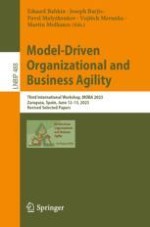2023 | Buch
Model-Driven Organizational and Business Agility
Third International Workshop, MOBA 2023, Zaragoza, Spain, June 12–13, 2023, Revised Selected Papers
herausgegeben von: Eduard Babkin, Joseph Barjis, Pavel Malyzhenkov, Vojtěch Merunka, Martin Molhanec
Verlag: Springer Nature Switzerland
Buchreihe : Lecture Notes in Business Information Processing
